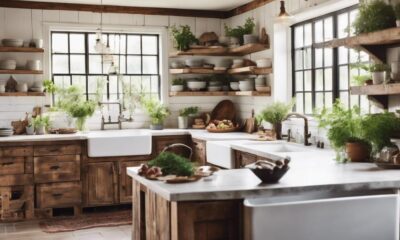Lifestyle
Farmhouse Bedroom Ideas – Design Your Dream Space
Unlock the secrets to designing your dream farmhouse bedroom and discover how to create a serene escape that reflects your unique style.
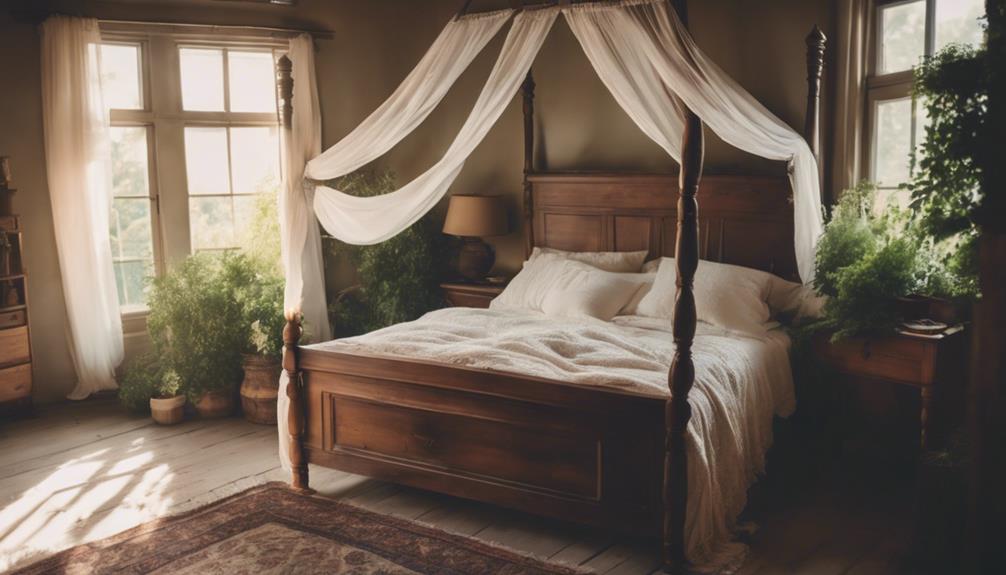
You can easily turn your bedroom into a calming farmhouse escape by focusing on natural materials and a neutral color palette. Choose a statement bed frame to anchor the space and incorporate layered textiles like quilts and pillows for added comfort. Functional nightstands and multifunctional furniture can help keep things organized while maintaining style. Don't forget to introduce rustic lighting, such as wooden chandeliers or table lamps, to create warmth. Personal touches, like cherished decor or travel souvenirs, will make it truly yours. Keep exploring for more tips on crafting your dream farmhouse-inspired bedroom.
Key Takeaways
- Embrace a neutral color palette with whites, creams, and muted pastels to create a calming atmosphere in your farmhouse bedroom.
- Incorporate natural materials like wood and linen, and layer textures with quilts and pillows for added comfort and depth.
- Select a statement bed frame as the focal point, complemented by functional nightstands for style and storage.
- Use creative storage solutions such as vintage trunks and open shelving to maintain organization while showcasing decor.
Overview of Farmhouse Bedroom Style
The farmhouse bedroom style blends comfort and simplicity, featuring a neutral color palette and natural materials that create a warm, inviting atmosphere. This decor embraces neutral colors like whites, creams, and soft grays, often enhanced with earthy tones to evoke a sense of tranquility.
You'll love how the rustic style comes to life through the use of natural materials like wood, linen, and cotton, which add authenticity to the space. Incorporating layered textiles is vital for achieving that cozy feel. Think quilts, throws, and decorative pillows that not only provide comfort but also contribute visual interest to your bedroom.
To further enhance the farmhouse aesthetic, consider adding distressed finishes on furniture and vintage accessories that lend character and a sense of history to the room. Architectural features play a significant role, too. Elements like shiplap walls and board and batten treatments add texture and depth, reinforcing the inviting vibe of farmhouse design.
Key Design Elements
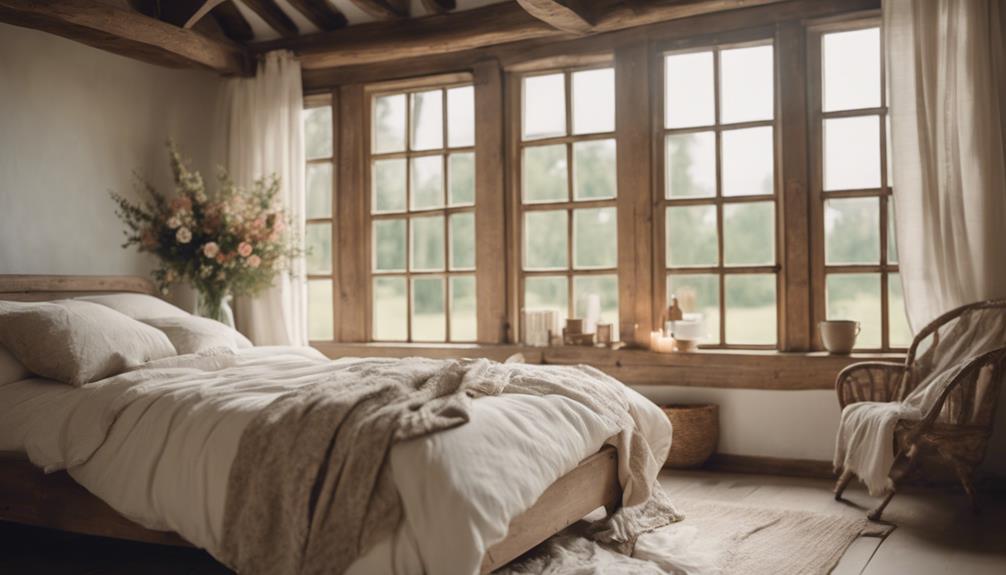
When creating your farmhouse bedroom, focus on key design elements that set the tone.
Start with a neutral color palette to establish a serene atmosphere.
Then consider furniture arrangement to maximize space and comfort.
Color Palette Selection
Selecting the right color palette is essential for crafting a serene and inviting farmhouse bedroom that reflects your personal style. Start with a neutral color palette featuring whites, creams, grays, and soft pastels to create a calming and airy atmosphere. These shades set the foundation for a cozy environment where you can unwind.
Next, consider incorporating accent colors that enhance the serene feel. Muted blues and greens work beautifully in this scenario, adding subtle personality without overwhelming the space. You can also use darker shades for contrast, grounding your design and providing visual interest.
To evoke warmth and connect your interior to nature, integrate earthy tones like warm browns and soft taupes. These colors reinforce the farmhouse aesthetic and contribute to a cozy atmosphere.
Furniture Arrangement Tips
Prioritizing a statement bed frame can instantly elevate your farmhouse bedroom's design and create a stunning focal point. Choose a wooden or upholstered option that resonates with the farmhouse aesthetic, setting the tone for the rest of the room.
On either side, arrange functional nightstands that not only complement the bed frame but also provide ample storage for essentials.
To enhance comfort and functionality, include a cozy seating area, like a plush chair or a stylish bench. This nook can serve as a perfect spot to unwind or read. Additionally, consider incorporating open shelving to display decor items and books, adding character and keeping the space organized.
Don't forget about multifunctional pieces; storage ottomans or trunks can help maintain an uncluttered environment while serving as stylish accents.
These elements work together to create a harmonious flow and maximize your space, making your farmhouse bedroom both inviting and functional. By thoughtfully arranging these key design elements, you'll achieve a beautifully balanced bedroom that reflects your unique style and enhances your overall living experience.
Textural Elements Importance
Textural elements play an essential role in defining your farmhouse bedroom's character, creating a warm and inviting atmosphere that beckons you to relax. By mixing materials like wood, metal, and fabric, you can establish a rich visual tapestry that enhances the overall aesthetic.
A cozy atmosphere is achieved through thoughtful layering of different textures. Incorporate soft textiles against hard surfaces to invite tactile experiences that promote comfort. Use quilts, throws, and pillows to add depth and visual interest to your space.
Here's a quick overview of textural elements to evaluate:
| Element | Purpose |
|---|---|
| Soft Textiles | Create comfort and a cozy atmosphere |
| Natural Elements | Introduce organic textures and harmony |
| Layering Textures | Enhance visual interest and depth |
Emphasizing these tactile experiences—like woven throws and vintage fabrics—fosters a warm and inviting environment in your bedroom. When you blend these elements thoughtfully, you not only enhance the aesthetic but also create a space that feels like home.
Color Palette and Textures
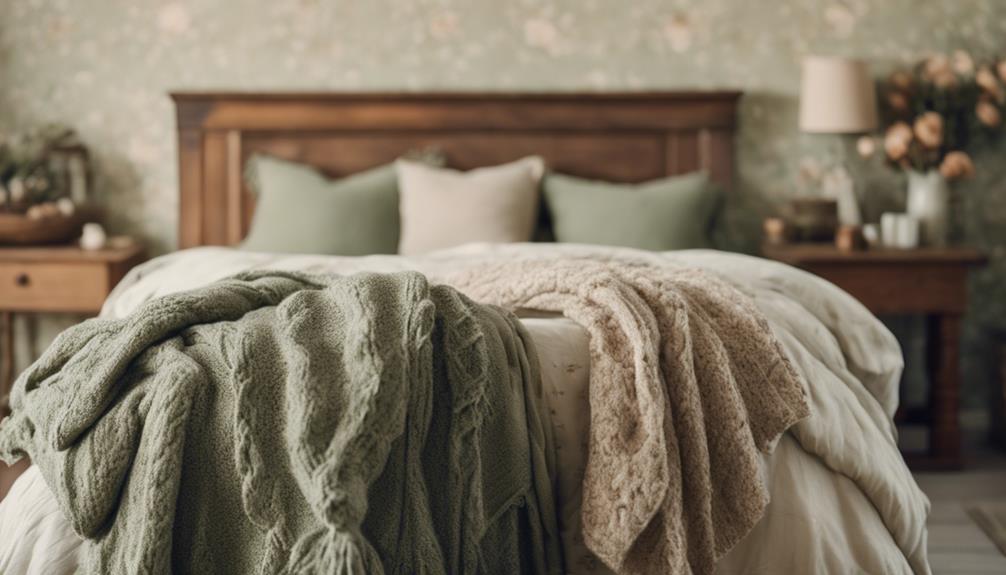
When it comes to your farmhouse bedroom, choosing a neutral color palette sets a calming tone.
You can enhance the space by layering textures with cozy textiles and selecting patterns that add a charming touch.
Let's explore how these elements work together to create the perfect farmhouse retreat.
Neutral Color Combinations
A neutral color palette in your farmhouse bedroom creates a serene atmosphere, featuring whites, creams, soft grays, and muted pastels that invite relaxation. By incorporating earthy tones, you can enhance warmth and coziness, providing depth without overwhelming the space. This combination promotes a soothing environment, perfect for unwinding after a long day.
To achieve the ideal neutral color combination, consider these elements:
- Soft whites for a clean, fresh look
- Muted pastels to add subtle color without distraction
- Earthy tones like taupe or sage to create warmth
- Natural materials such as wood and stone to reinforce the rustic farmhouse aesthetic
Layering Textures Effectively
To create a cozy farmhouse bedroom, effectively layering textures can enhance the serene atmosphere established by your neutral color palette. Start with a base of whites, creams, and soft grays to create a calming backdrop. Then, incorporate materials like wood, linen, and cotton to boost the room's coziness and authenticity.
Layer your bedding with quilts, throws, and decorative pillows to add depth and comfort, making the space inviting. Choose decorative pillows in various textures and sizes to create visual interest while sticking to your neutral theme.
Don't forget about area rugs; natural fiber rugs can introduce warmth and texture while defining different areas within the room.
You can also play with layering textures by mixing different materials in your furnishings, such as a wooden bed frame paired with a soft linen duvet. This blend contributes to the overall farmhouse aesthetic.
Pattern Selection Tips
How can you select patterns that enhance your farmhouse bedroom while keeping the space feeling cohesive and serene?
Start by prioritizing a neutral color palette with whites, creams, and soft pastels. This creates a calm atmosphere while allowing muted blues or greens to act as subtle accents.
Next, consider the following pattern selection tips to keep your space inviting:
- Use patterned textiles like ticking stripes or buffalo checks for bedding and throw pillows.
- Mix solids with subtle prints to balance the visual interest without overwhelming the room.
- Layering textures, such as cotton, linen, and wool, adds depth and comfort.
- Incorporate natural materials, like wooden furniture and woven accents, to emphasize the farmhouse aesthetic.
Furniture Selection Tips
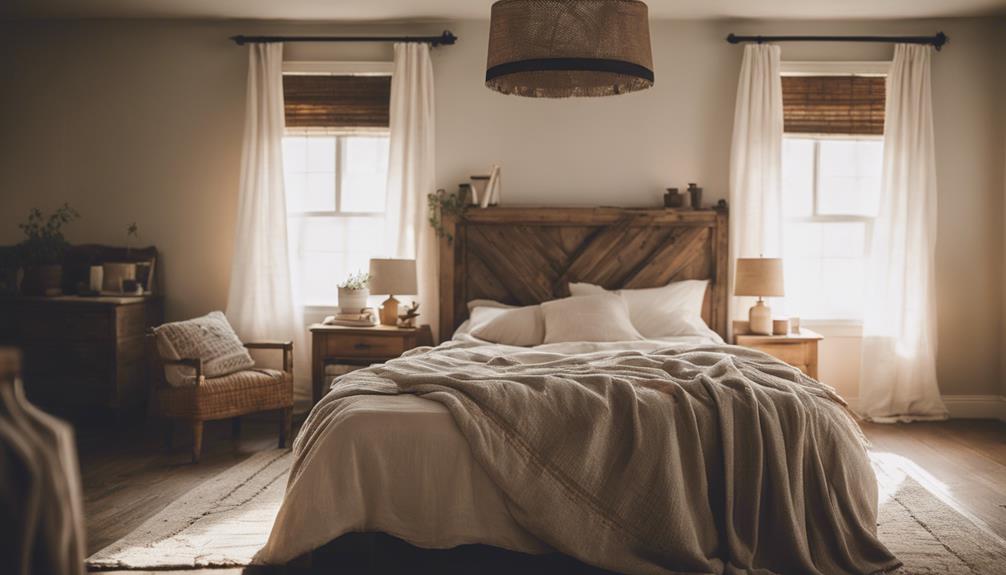
Selecting the right furniture is key to creating a functional and inviting farmhouse bedroom. Begin with statement furniture pieces that embody the modern farmhouse look, like a sturdy wooden or upholstered bed frame. This not only enhances comfort but also serves as a focal point in your room.
To maximize space, consider incorporating multi-use furniture such as storage ottomans or trunks. These pieces provide functional storage while keeping your room organized.
Don't forget to add cozy seating areas with comfortable chairs or benches—perfect for relaxing or enjoying a good book.
For a personalized touch, utilize open shelving to display your favorite decor items and books. This not only saves floor space but also adds character to your farmhouse aesthetic.
When choosing furniture, prioritize rustic wood styles or vintage pieces that align with the overall charm of your bedroom. Each selection should contribute to a cohesive design that feels warm and inviting.
Creative Storage Solutions
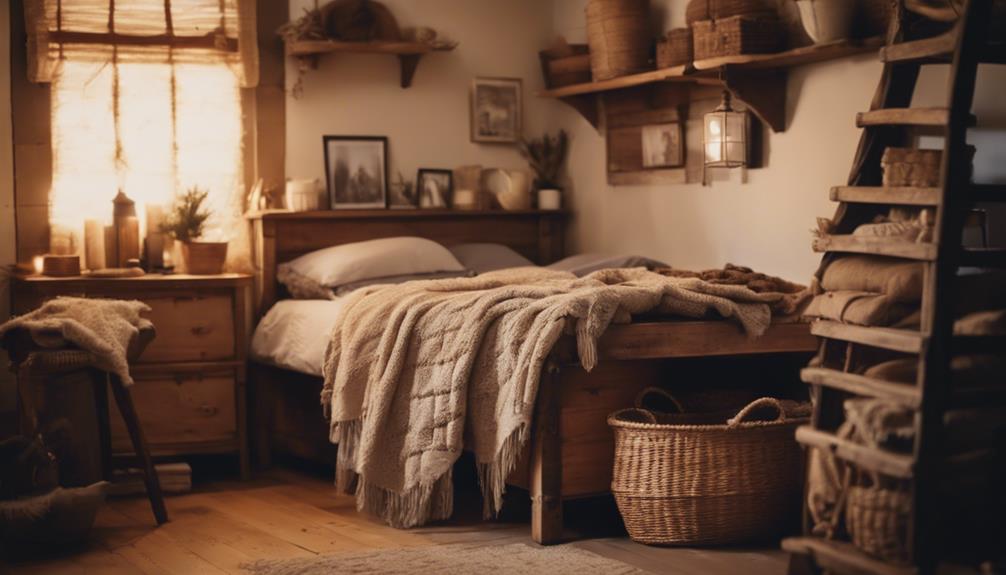
Creating an inviting farmhouse bedroom goes hand-in-hand with innovative storage solutions that keep your space organized and clutter-free. You can blend functionality with charm by incorporating several creative storage solutions that complement the farmhouse aesthetic.
Built-in window seats serve as cozy spots while offering hidden storage for pillows and blankets.
Repurposed furniture, like a nightstand made from a junkyard ladder, adds rustic flair and extra storage.
Vintage trunks can be both decorative and practical, providing hidden storage for seasonal items or extra linens.
Open shelving is perfect for displaying your favorite decor and books while keeping surfaces neat and tidy.
Custom-built bookshelves can utilize unique wall shapes, maximizing storage and showcasing your antiques.
Lighting and Ambiance
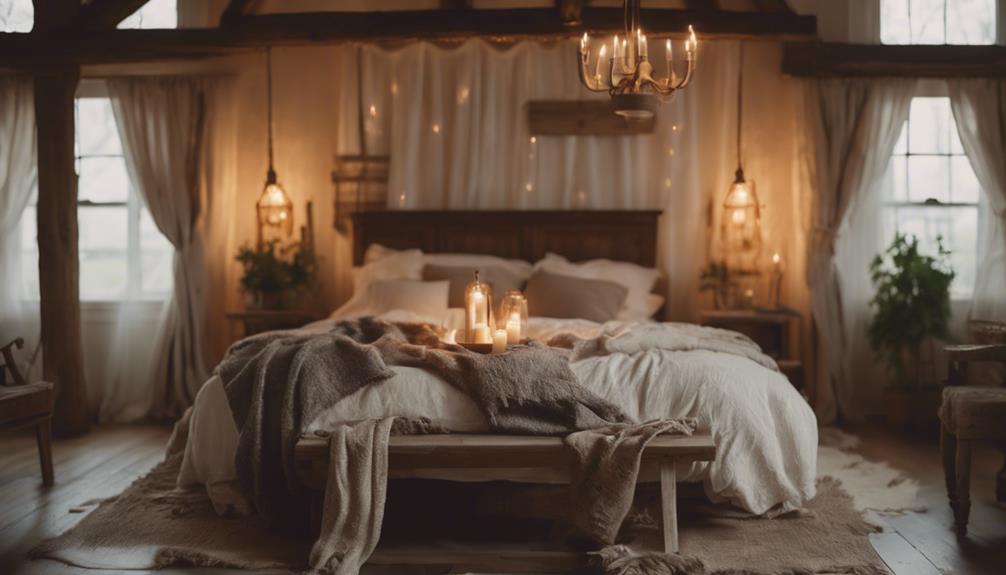
What better way to enhance the cozy charm of your farmhouse bedroom than by incorporating warm, inviting lighting that sets the perfect ambiance?
Start with rustic chandeliers made from wood or wrought iron; they serve as stunning focal points while providing essential ambient light.
Don't forget about versatility—swing arm wall lamps can elevate your lighting game, offering both style and functionality.
Table lamps with fabric shades are another great choice, creating a soft, inviting atmosphere ideal for reading or unwinding in bed.
Layer your lighting sources for added depth; think pendant lights and string lights that complement your farmhouse decor while crafting a warm, cozy vibe.
Maximize natural light too—opt for sheer curtains that allow sunlight to pour in, brightening your space and maintaining that breezy feel you love.
Each lighting element you choose should harmonize, working together to create a sanctuary that reflects your personal style.
With these thoughtful lighting strategies, your farmhouse bedroom will be a welcoming retreat, blending comfort and elegance seamlessly.
Personal Touches and Decor

To truly make your farmhouse bedroom feel like home, adding personal touches and decor that reflect your unique story is key. By incorporating elements that resonate with your life experiences, you'll create a space that feels both inviting and meaningful.
Here are some ideas to inspire your decor:
- Family heirlooms: Showcase treasured items that tell your family's history.
- Custom artwork: Display your own creations or those of loved ones for a personal touch.
- Travel souvenirs: Incorporate items from your adventures that spark joy and memories.
- Curated vignettes: Combine books, plants, and decorative pieces to form serene and organized displays.
These farmhouse elements enhance the charm of your bedroom while weaving your story into the space.
Remember to balance personal touches with restraint, ensuring your room feels both lived-in and thoughtfully designed.
Frequently Asked Questions
How to Make a Bedroom Look Farmhouse?
To make your bedroom look farmhouse, use a neutral color palette, incorporate natural materials like wood, and layer textiles for warmth. Add shiplap walls and vintage finds for authenticity and charm that invites relaxation.
How to Design Your Dream Bedroom?
Designing your dream bedroom's like crafting a cozy nest. Start by outlining ideas and budget, choose a calming color palette, incorporate multifunctional furniture, layer bedding, and add personal decor to reflect your unique style.
How to Decorate a Real Farmhouse?
To decorate a real farmhouse, you'll want to embrace reclaimed wood, vintage furniture, and a neutral color palette. Layer natural textiles, incorporate functional furniture, and add architectural details for a cozy, authentic atmosphere.
How Do I Make My Living Room Look Like a Farmhouse?
Picture warm, reclaimed wood accents and soft, neutral hues enveloping your living room. Layer in cozy textiles, vintage decor, and shiplap walls to create a rustic, inviting atmosphere that embodies farmhouse charm effortlessly.
How Can I Use Farmhouse Decor Ideas to Design My Dream Farmhouse Bedroom?
Transform your farmhouse space with charming farmhouse decor ideas to create your dream farmhouse bedroom. Incorporate rustic wooden furniture, cozy bedding, and vintage accessories for a cozy and inviting atmosphere. Add soft lighting, natural textures, and floral accents to complete the look and make your bedroom a relaxing retreat.
Conclusion
You've explored the charm of farmhouse bedroom ideas, and now it's time to bring your vision to life.
Imagine stepping into a cozy retreat that reflects your personality and style.
By embracing key design elements, color palettes, and personal touches, you can create a space that's not just beautiful but also inviting.
So, why wait? Immerse yourself in your project and watch as your dream farmhouse bedroom transforms into a reality, welcoming you home each day.
Lifestyle
How to Use Feng Shui to Turn Your Home Into a Peaceful Sanctuary
You can transform your home into a tranquil haven with Feng Shui, but what essential steps should you take first? Discover the secrets within.

To turn your home into a peaceful sanctuary using Feng Shui, start by decluttering to improve energy flow. Arrange your furniture for easy movement and choose calming colors like soft blues and greens. Incorporate natural elements, such as indoor plants and nature-themed artwork, to enhance relaxation. Personalize your space with meaningful decor that reflects who you are, and consider seasonal adjustments to maintain a fresh atmosphere. By focusing on these principles, you'll cultivate a serene environment that supports your well-being. Explore further ways to enrich your sanctuary and fine-tune your cozy retreat.
Key Takeaways
- Declutter regularly to enhance energy flow, creating a serene environment free from distractions.
- Incorporate calming colors like soft blues and greens to promote tranquility throughout your home.
- Use nature-themed artwork and indoor plants to uplift mood and encourage a connection with nature.
- Personalize your space with meaningful decor and photographs to foster warmth and emotional connections.
- Assess furniture layout to ensure easy movement and open pathways, allowing for effortless energy flow.
Understanding Feng Shui Basics

Feng Shui, often viewed through the lens of ancient wisdom, is all about creating a harmonious environment that nurtures your well-being. It translates to "the way of wind and water" and emphasizes how the arrangement of spaces can enhance mental clarity and overall health.
In your living room, for instance, the layout can greatly impact your emotional state. To create harmony, consider integrating natural materials and textures to further enhance the calming atmosphere.
To create harmony, pay attention to the flow of chi, or life energy. You can influence this energy by rearranging furniture to allow for open pathways and by decluttering surfaces.
Each area of your home corresponds to different aspects of life, so verify your living room reflects positivity and balance.
Incorporating natural elements, like plants, can also boost the energy in your space. Use colors that resonate with you and promote tranquility—soft blues and greens are often recommended.
Ultimately, by embracing these principles of Feng Shui, you can cultivate a serene and inviting living room that fosters relaxation and peace, making it a true sanctuary for you and your loved ones.
Assessing Your Space
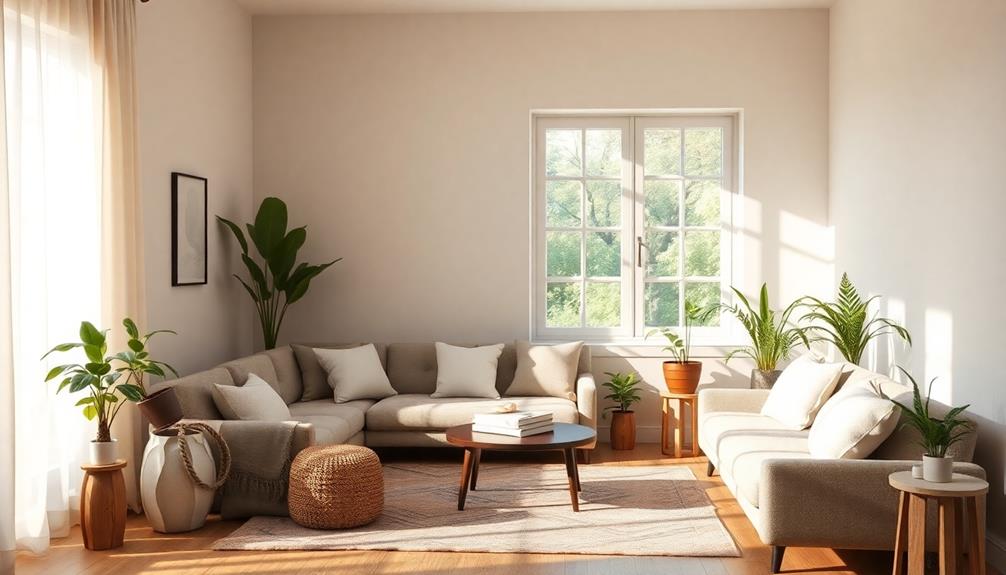
Evaluating your space is essential for creating a peaceful home environment. Start by analyzing the flow of energy, known as chi, throughout your home. Identify areas that feel stagnant or cluttered, as these disrupt tranquility and harmony.
Incorporating elements such as vibrant Indonesian decorative pillows can enhance the comfort of your space while reflecting cultural heritage, adding to the overall positive energy. Make sure your furniture layout allows for easy movement and interaction, so energy can flow freely and effortlessly.
Next, pay attention to the colors in your space. Opt for calming shades like blues and greens that evoke relaxation, while minimizing aggressive colors like red, which can create tension. The right colors can greatly enhance your emotional impact, promoting a serene atmosphere.
Additionally, consider using natural materials in your decor, such as bamboo and wood, which are commonly found in Indonesian kitchen decor to create a warm and inviting ambiance.
Regularly engage in decluttering and space clearing practices. Keeping your home organized not only creates an inviting environment but also enhances the overall energy.
Remove items that no longer serve a purpose or bring you joy, making space for positive energy to flourish.
Artwork and Decor Selection

Choosing the right artwork and decor can greatly enhance the peaceful atmosphere you've created in your home. Opt for wall art that symbolizes peace and relaxation, like nature-themed pieces featuring cherry blossoms. These evoke calmness and joy, vital for your sanctuary.
Avoid chaotic imagery in bedrooms and living areas, as they can trigger stress and anxiety. Replace any violent decor, such as weapon-shaped items, with serene alternatives that promote tranquility. Calming colors and soothing imagery in your artwork are essential; steer clear of excessive reds, which can lead to heightened drama.
Personalizing your space with meaningful art that resonates with you will enhance your overall well-being. Here's a quick reference table to guide your decor choices:
| Symbolism | Recommended Artwork | Avoid |
|---|---|---|
| Peace | Nature scenes | Chaotic patterns |
| Harmony | Abstract calm art | Violent imagery |
| Relaxation | Soft landscapes | Dark, aggressive art |
| Joy | Bright, uplifting pieces | Stressful visuals |
| Personalization | Meaningful photos | Generic decor |
Incorporate these elements to create your peaceful sanctuary.
Decluttering for Serenity
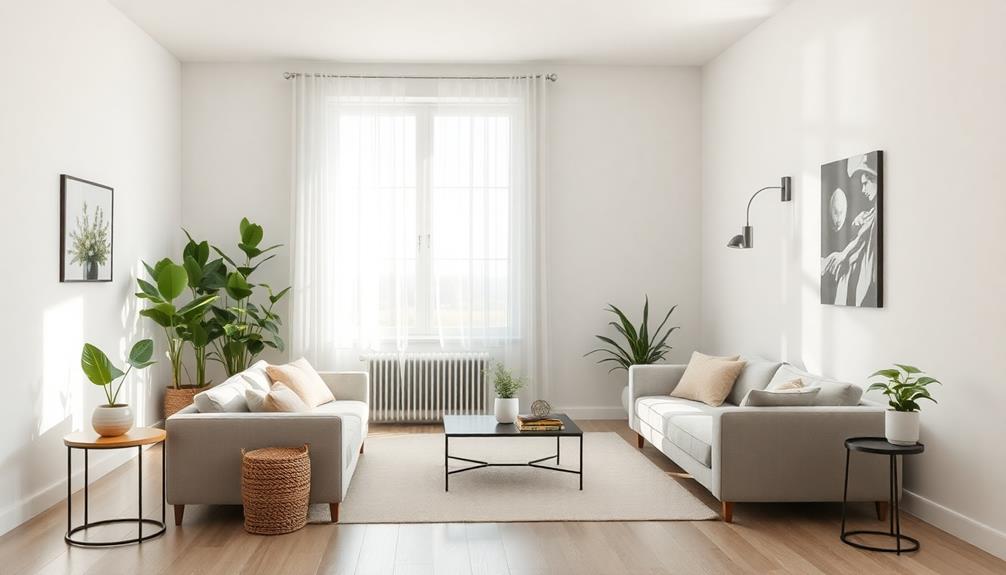
Decluttering your home can greatly enhance your sense of serenity and well-being. By regularly engaging in decluttering, you improve the energy flow within your space, creating a serene environment that supports mental clarity and relaxation.
Start by removing items that no longer serve a purpose; this space clearing technique refreshes the energy in your living areas. Incorporating natural materials in your decor, such as wood and bamboo, can further amplify this sense of tranquility, as seen in traditional Indonesian style home decor.
Organization is key to maintaining that serene atmosphere. Implementing effective storage solutions and designating specific areas for different activities helps prevent chaos. When everything has its place, you'll find it easier to keep your home tidy and peaceful.
Consider using labeling systems for easy access to necessary items. This approach simplifies your environment and encourages mindfulness in your organization process.
Remember, decluttering not only reduces visual distractions but also alleviates the low-level stress that often accompanies a cluttered space.
As you systematically declutter, you'll notice a significant improvement in your overall well-being. Embrace the process, and you'll create a harmonious home that fosters tranquility and balance.
A serene environment is within your reach, and it all starts with a commitment to decluttering.
Color Choices for Peacefulness
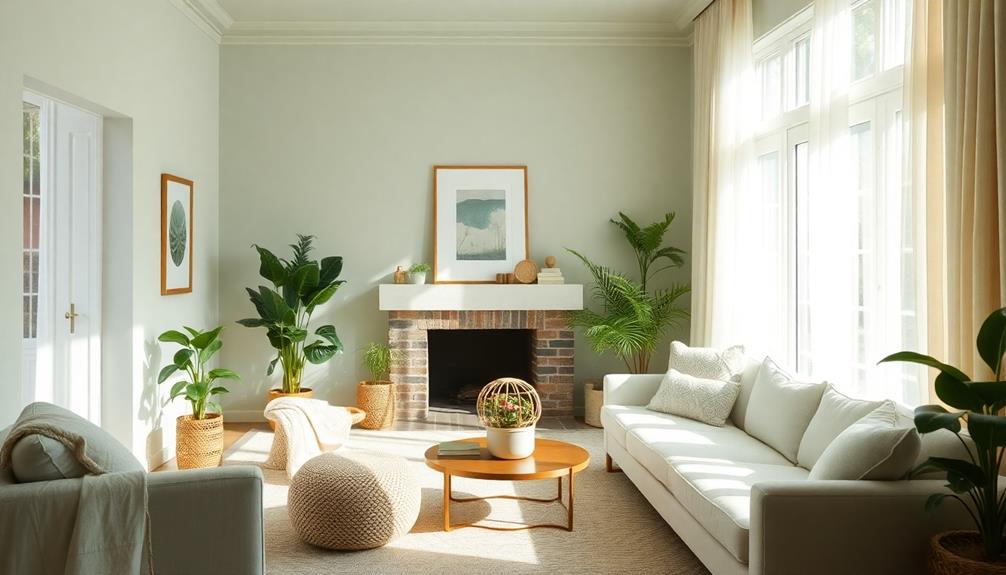
Creating a peaceful atmosphere in your home can be greatly influenced by your color choices. To foster tranquility, consider using soft colors like blue and green, which evoke feelings of calmness and renewal.
These calming colors work wonders in living spaces, making them ideal for promoting relaxation. Incorporating elements of traditional artistry through decor masks can further enhance the serene environment, as they add a unique cultural touch.
In line with Feng Shui principles, it's important to avoid excessive use of red, as it can lead to heightened emotions and anxiety. Instead, opt for earth tones such as beige and soft browns, which provide a sense of stability and grounding.
These colors contribute to a balanced ambiance that enhances your home's serenity.
Additionally, incorporating pastel shades in bedrooms and relaxation areas can considerably boost feelings of comfort and peace.
These gentle hues create a restful environment, perfect for winding down after a long day.
Incorporating Natural Elements
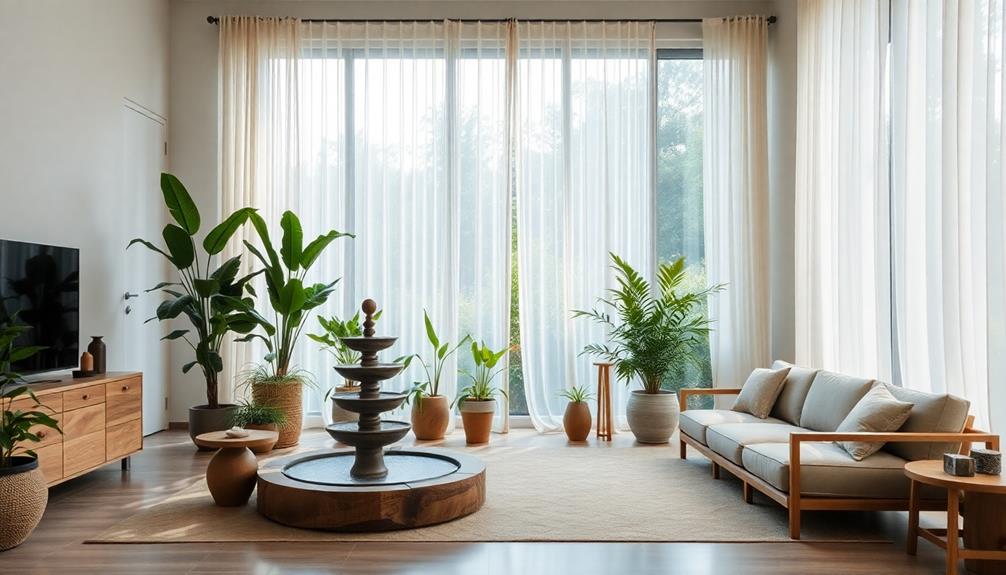
Incorporating natural elements like indoor plants and nature-themed artwork can greatly enhance the serenity of your home.
Additionally, adding a unique touch with culturally significant art, such as an Indonesian decor mask, can't only serve as a conversation starter but also infuse your space with rich artistic expressions.
Plants not only purify the air but also create a calming atmosphere, while art depicting landscapes or flowers can uplift your mood.
Benefits of Nature Art
When you surround yourself with nature-themed artwork, it can transform your living space into a sanctuary of calm and beauty. Incorporating pieces like landscapes or floral designs helps create a peaceful atmosphere that promotes relaxation and serenity.
Additionally, integrating unique cultural elements, such as Indonesian decor masks, further enhances the tranquility of your environment. Studies show that viewing nature art reduces stress levels, enhancing your emotional well-being, making it an ideal addition to spaces like your bedroom or living room.
Choosing serene imagery—think cherry blossoms or tranquil forests—replaces chaotic visuals and aligns with Feng Shui principles. This alignment not only fosters harmony in your home but also encourages a deeper connection to the outdoors, which can lead to improved mental clarity and reduced anxiety.
Moreover, displaying nature-themed artwork serves as a constant reminder of the beauty and tranquility found in nature. It nurtures a sense of joy and contentment in your daily life, reinforcing the sanctuary-like quality of your home.
Indoor Plants for Serenity
Indoor plants bring a revitalizing energy to your home while promoting serenity and well-being. Incorporating indoor plants like peace lilies, snake plants, and pothos not only purifies the air but also enhances the overall energy flow, aligning with Feng Shui principles.
Additionally, you can draw inspiration from Indonesian Wedding Decor Ideas by using vibrant colors and natural elements in your plant arrangements, creating a harmonious blend of aesthetics and tranquility. These plants create a peaceful sanctuary that fosters tranquility.
To attract positive energy and prosperity, consider adding bamboo and jade plants. Placing them in specific areas, such as the wealth corner (the far left corner from the entrance), amplifies their benefits and nurtures a sense of abundance. This intentional positioning helps cultivate an environment of peace and positivity.
Utilizing a variety of plant sizes and textures not only contributes to visual harmony but also creates a calming atmosphere. The diversity of greenery can make your space feel more inviting and vibrant.
Regular care and attention to your indoor plants encourage mindfulness and a deeper connection to nature, further enhancing the peaceful ambiance of your home.
Personalizing Your Sanctuary

Transform your sanctuary into a personal haven that reflects who you are. To achieve this, start by displaying personal photographs of loved ones or cherished memories. This creates an emotional connection and infuses warmth into your space.
Surround yourself with favorite objects or souvenirs that bring you joy, ensuring your sanctuary truly represents your unique personality and experiences. Incorporating elements from luxury tropical designs can further enhance the tranquil atmosphere of your retreat.
Consider creating a cozy reading nook with comfortable seating and good lighting. This not only encourages relaxation but also fosters personal reflection.
Position your furniture near windows to utilize natural light, enhancing the inviting atmosphere of your personalized space.
Choose decor elements, such as artwork or textiles, that resonate with your personal style and preferences. These beautiful things can create a sense of belonging and tranquility, making your sanctuary feel like an extension of yourself.
Seasonal Adjustments for Comfort

Seasons change, and so should your sanctuary to guarantee it remains a comfortable retreat throughout the year. By making seasonal adjustments, you can enhance the ambiance of your home and maintain a sense of peace.
Here are some tips for transforming your living rooms with seasonal decor:
- Warm Textiles: Swap out lightweight throws for cozy blankets and add plush cushions during colder months to increase comfort and warmth. This aligns with the concept of creating multifunctional spaces that promote relaxation and entertainment in your home.
- Nature-Inspired Decor: Incorporate elements like autumn leaves or winter greenery to refresh your space, creating a connection with nature's cycles. Consider integrating tropical plants that reflect the changing seasons for a lively atmosphere.
- Temperature Control: Use fireplaces or heated blankets in winter for warmth, while in summer, open windows or utilize ceiling fans for a cool, airy feel.
- Vibrant Plants: Rotate in seasonal plants or flowers that reflect the climate, bringing life to your home and keeping your sanctuary lively.
Frequently Asked Questions
How Do I Make My House Feel Like a Sanctuary?
To make your house feel like a sanctuary, start decluttering, use calming colors, incorporate nature-themed decor, and create cozy spaces. Soft lighting and soothing scents will enhance the atmosphere, inviting relaxation and peace.
How Can I Make My Home a Place of Peace?
To make your home a place of peace, clear clutter regularly, use calming colors, incorporate nature-inspired decor, and create cozy seating arrangements. Add soothing scents and sounds to enhance the tranquil atmosphere you desire.
How Can I Make My Home Peaceful and Tranquil?
To make your home peaceful and tranquil, clear clutter, use calming colors, incorporate nature, and add soft lighting. Personalize your space with meaningful decor, and arrange furniture to foster comfort and harmony throughout.
How to Bring Peace at Home Feng Shui?
Imagine stepping into a serene oasis. You can bring peace at home by decluttering, choosing calming colors, and arranging furniture for comfort. Add plants and regularly cleanse your space to maintain that tranquil vibe.
Conclusion
By applying Feng Shui principles, you can transform your home into a peaceful sanctuary that nurtures your well-being. Did you know that a study found that 73% of people feel calmer and more focused in environments designed with Feng Shui in mind? So, take the time to assess your space, declutter, and incorporate natural elements. With these changes, you'll create a harmonious atmosphere that supports relaxation and rejuvenation, making your home a true retreat.
Lifestyle
5 Feng Shui Color Hacks That Will Instantly Balance Your Space
Incorporate these 5 Feng Shui color hacks to transform your space instantly; discover which colors can elevate your energy and enhance your well-being.
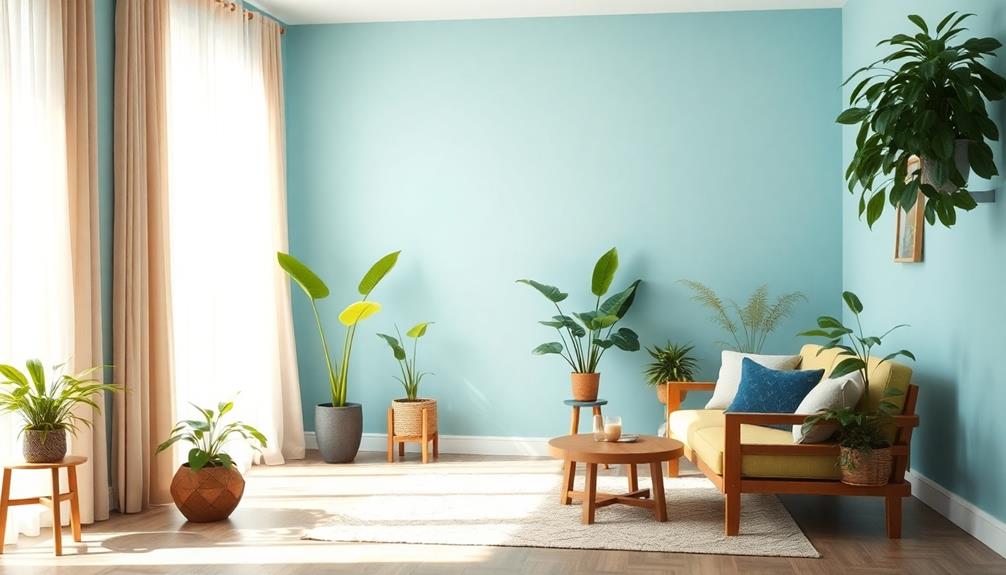
To instantly balance your space with Feng Shui, start by understanding color energy associations. Incorporate calming blues or energizing reds based on your room's purpose. Choose harmonious combinations like turquoise and salmon for growth and liveliness. Don't forget to add air-purifying plants for an inviting atmosphere and improved energy flow. Use accent colors strategically; yellows can brighten and uplift, while soft greens create tranquility. Finally, assess your lighting—warm tones for relaxation and cool tones to enhance focus. With these hacks in mind, you'll create a balanced environment that resonates with your personal energy. There's more to explore!
Key Takeaways
- Incorporate calming blues and soft greens to promote tranquility and balance, enhancing overall energy flow in your space.
- Use red accents to stimulate energy and passion, especially in dynamic areas for a lively atmosphere.
- Layer natural light with warm and cool lighting to create depth and adjust the mood according to the space's purpose.
- Strategically place air-purifying plants like snake plants to absorb negative energy, fostering a welcoming and vibrant environment.
- Combine harmonious colors like lavender and salmon to invite abundance while maintaining a sense of calm and relaxation.
Understand Color Energy Associations

Understanding color energy associations can transform your space and mood. By choosing the right colors, you can create a sense of balance and harmony in your environment.
For instance, blue and black evoke feelings of calmness, enhancing concentration while lowering blood pressure. If you're seeking to energize a space, consider red, which is linked to passion and increases heart rate, helping to uplift your spirit and alleviate feelings of depression. Incorporating vibrant colors through Indonesian decorative pillows can further enhance your living space and reflect cultural heritage.
Green represents growth and action, motivating internal change and revitalizing energy in a room. It's perfect for spaces where you want to inspire creativity and personal development.
Yellow, associated with the earth element, infuses hope, stabilizes emotions, and aids focus—especially beneficial in learning environments for children with dyslexia.
Lastly, white and metallic colors symbolize purity and clarity. They encourage carefulness and focus, making them ideal for areas that require tranquility and concentration.
Choose Harmonious Color Combinations

When you choose harmonious color combinations, you can greatly enhance the energy of your space. Using thoughtful pairings can considerably alter the Feng Shui energy in your home, creating an environment that fosters both activity and relaxation. For instance, combining salmon, which harmonizes earth and fire, invites abundance and encourages lively conversations. On the other hand, turquoise blends wood and water, promoting movement and growth while revitalizing your atmosphere.
To help you visualize effective color combinations, here's a simple guide:
| Energizing Colors | Calming Colors | Effect |
|---|---|---|
| Salmon | Lavender | Promotes abundance and calmness |
| Red | Blue | Balances activity with relaxation |
| Turquoise | Soft Green | Supports growth and tranquility |
Incorporate Plants for Vitality
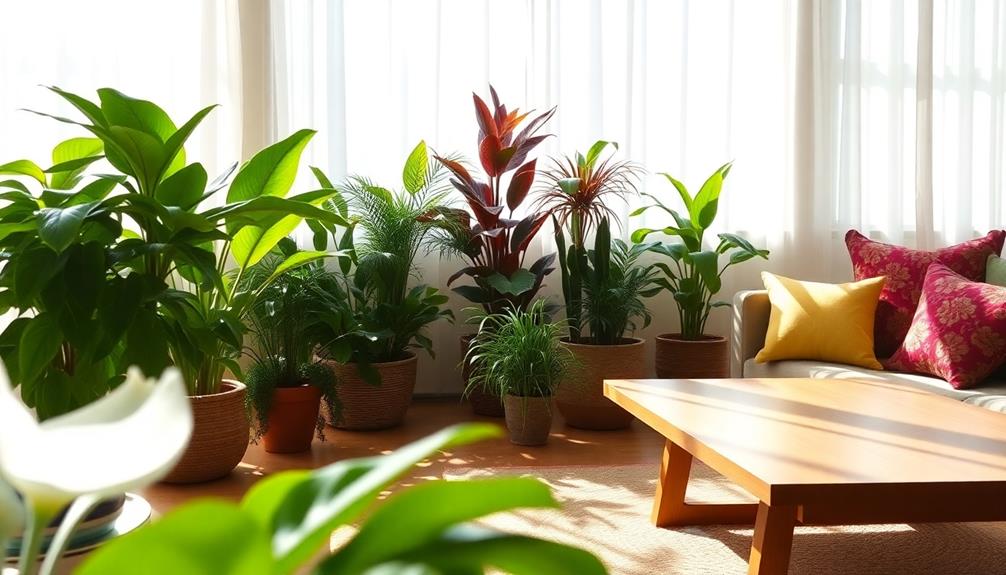
Bringing plants into your home is one of the simplest and most effective ways to boost liveliness and enhance your space's energy. Incorporating plants not only improves indoor air quality but also infuses your environment with vibrancy, much like adding a unique Indonesian decor mask that reflects cultural heritage.
Here are three ways to maximize their benefits:
- Choose the Right Plants: Opt for air-purifying varieties like snake plants and peace lilies. These plants can eliminate up to 60% of indoor pollutants in just 24 hours, inviting positive energy into your space.
- Strategically Place Your Plants: Position them in entryways and living areas to absorb negative energy while creating a welcoming atmosphere. This placement helps cultivate a balanced and vibrant energy flow.
- Mix It Up: Use a variety of plants with different leaf shapes and sizes. This diversity not only adds visual interest but also contributes to a harmonious energy balance throughout your decor.
Regularly caring for your plants fosters a connection to nature, enhancing your overall well-being and emotional health.
Use Accent Colors Strategically

Accent colors play an essential role in shaping the mood and energy of your space, allowing you to express your personality while enhancing the overall environment. By choosing accent colors based on their emotional impact, you can greatly influence the energy flow and create a harmonious atmosphere.
To help you choose wisely, here's a quick reference:
| Accent Color | Emotional Impact |
|---|---|
| Red | Stimulates energy and passion |
| Blue | Promotes calmness and focus |
| Green | Balances and refreshes |
| Yellow | Invokes joy and optimism |
| Purple | Inspires creativity and luxury |
Use accent colors in small doses with accessories like pillows, art, or decor to maintain balance and avoid overwhelming your space. For instance, pairing calming greens with energizing yellows can enhance harmony. Also, strategically placing warm tones near entryways invites positive chi, while cooler shades in bedrooms promote relaxation.
Assess Room Lighting and Mood
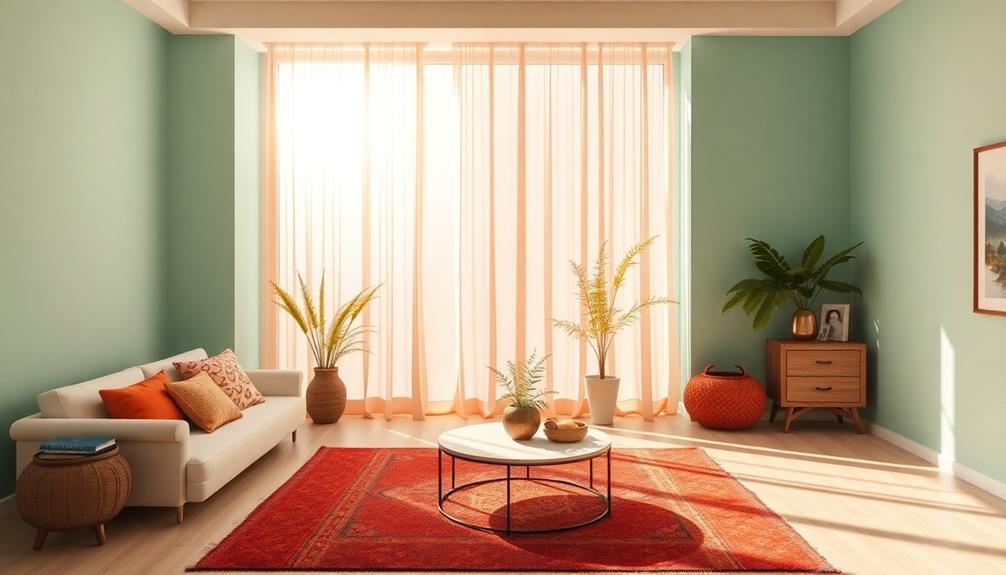
Room lighting greatly impacts your mood and the overall energy of a space. To create a balanced environment, you'll want to assess the lighting carefully. Here are three key considerations:
1. Maximize Natural Light: Open your curtains and blinds during the day. Natural light boosts your mood and liveliness, enhancing energy flow throughout the room.
Incorporating indoor-outdoor living elements can further amplify this effect by blurring the lines between your interior and exterior spaces.
2. Layer Your Lighting: Incorporate ambient, task, and accent lights. This mix creates depth and warmth, while soft, diffused lighting promotes relaxation.
It's essential to avoid harsh lighting, as it can disrupt your mood.
3. Choose the Right Color Temperature: Warm light (2700K-3000K) creates a cozy atmosphere, ideal for relaxation.
In contrast, cooler light (4000K-5000K) enhances focus and alertness, perfect for workspaces.
Don't forget about dark corners—they can indicate neglected areas of life. Use mirrors to reflect light and brighten these spaces, amplifying overall energy.
Regularly evaluate your room's lighting conditions to maintain a harmonious balance, as insufficient light can lead to stagnation and reduced energy flow.
Frequently Asked Questions
What Colors Should Be Avoided in Feng Shui?
In Feng Shui, avoid strong colors like red and black, excessive gray, and bright white. Dark brown can weigh down energy, while neon colors disrupt tranquility. Choose wisely to maintain a balanced, harmonious environment.
What Color Should Your Bed Sheets Be Feng Shui?
For your bed sheets, choose calming colors like soft blues, greens, or neutrals. These shades promote relaxation and restful sleep. Avoid vibrant colors that can disrupt your peace and energy balance in the bedroom.
What Are the Feng Shui Colors for Creative Space?
For your creative space, use vibrant colors like orange and yellow to inspire joy, while greens promote balance and growth. Accents of red energize, and soft blues create tranquility, enhancing focus and creativity without overwhelming you.
What Are the Calming Colors for Feng Shui?
Calming colors in Feng Shui wash over you like a gentle wave. Soft blues and greens invite relaxation, while earthy tones ground your space. Pastels foster emotional balance, and neutrals enhance clarity, creating a serene environment.
Conclusion
By embracing these enchanting feng shui color hacks, you can effortlessly enhance your environment. Harmonious hues, lively plants, and savvy accent strategies will sprinkle serenity throughout your space. Remember to reflect on your room's lighting, as it plays a pivotal role in setting the mood. So, plunge into the delightful world of color and watch your surroundings transform into a tranquil haven that radiates balance and beauty!
Lifestyle
How Cooking Methods Affect Protein Digestibility
Understanding how cooking methods impact protein digestibility can transform your meals—discover the best techniques to maximize nutrition!

Cooking methods affect how well your body digests protein, impacting overall nutrition. Techniques like boiling can lead to nutrient leaching, reducing protein digestibility by about 25%. On the other hand, steaming helps retain nutrients and enhances amino acid composition, making it a better option. Cooking at ideal temperatures, around 75°C, improves protein absorption while excessive heat can hinder it. Additionally, different legumes show varying digestibility based on the cooking method used. By understanding these effects, you can make informed choices to enhance your meals. Want to discover more about the best cooking techniques for protein?
Key Takeaways
- Cooking methods significantly influence protein digestibility, with boiling potentially reducing it by up to 25% due to nutrient leaching.
- Steaming is superior to boiling, preserving amino acids and enhancing protein retention without direct water contact.
- Optimal cooking temperature around 75°C maximizes protein digestibility while minimizing nutrient loss from food.
- Cooking duration affects digestibility; shorter boiling times are recommended to retain nutrients and avoid leaching.
- Pressure cooking enhances protein digestibility more effectively than boiling or microwaving, benefiting legume types especially.
Overview of Protein Digestibility

When it comes to understanding protein digestibility, you'll find that it's all about how well your body breaks down protein into amino acids and absorbs them. Different protein sources vary in their digestibility, which means some foods provide more usable amino acids than others.
For instance, while meat and dairy typically offer high protein digestibility, plant-based sources can be less efficient due to their structure and fiber content. In Brazilian cuisine, diverse ingredients such as seafood and cassava showcase how various protein sources can influence digestion.
The cooking methods you choose can markedly impact protein digestibility as well. Boiling, roasting, and frying affect how proteins are broken down. For example, boiling can lead to nutrient leaching, reducing the protein's nutritional content and availability.
Studies reveal that raw insects have higher digestibility than their processed counterparts, with boiling causing a significant decrease in digestibility for certain species.
Temperature plays an essential role, too. Cooking at ideal temperatures, around 75°C, can enhance protein digestion rates, while excessive heat may decrease digestibility.
Ultimately, the way you prepare your food can alter its protein structure, influencing the release of amino acids during digestion and affecting how well your body absorbs them.
Impact of Cooking Techniques

The way you cook your food plays an essential role in how your body digests protein. Different cooking methods can greatly influence protein digestibility, affecting your nutritional profile and overall health. For instance, boiling can lead to protein leaching into the water, reducing digestibility by about 25% for processed insects.
In contrast, oven cooking and frying can enhance dry matter and lipid content, but if you opt for deep frying, you might face the lowest protein digestibility among various techniques. Additionally, incorporating fresh ingredients, such as in Nettle and Potato Soup, can provide not only crucial nutrients but also enhance the overall flavor profile of your meals.
Moreover, cooking methods can alter the amino acid composition. While deep frying enhances polyunsaturated fatty acids (PUFAs) in insects, it can compromise the protein's digestibility. Notably, steam cooking can increase beneficial linoleic acid content, showcasing how techniques vary in their effects.
You should also consider the oxidative status of your food; deep-fried and microwave-cooked samples often show higher tocol values than pan-fried options.
As you explore these cooking methods, remember that your choices can greatly affect the nutritional benefits you derive from your meals.
Boiling vs. Steaming Effects

Comparing boiling and steaming reveals significant differences in how each method affects protein digestibility and nutrient retention. When you choose between these two cooking techniques, keep the following points in mind:
1. Protein Loss: Boiling often results in a 25% decrease in protein digestibility, as proteins leach into the cooking water.
For instance, dishes like Chinese Steamed Egg showcase the benefits of steaming in preserving protein quality.
2. Nutrient Preservation: Steaming minimizes nutrient loss by avoiding direct contact with water, which helps maintain higher protein quality.
3. Mineral Bioaccessibility: Boiling can lead to a 50% decrease in the bioaccessibility of essential minerals like iron and zinc, while steaming preserves these minerals effectively.
4. Overall Nutritional Value: Steaming enhances the nutritional profile of food, making it a better choice for maintaining protein digestibility and essential nutrients.
Role of Temperature and Time

When you cook proteins, the temperature and time you choose play a vital role in their digestibility.
For instance, cooking methods used in dishes like Mushroom Masala can enhance flavors while still preserving nutrient content.
Ideal cooking at around 75°C balances efficiency and nutrient preservation, while cooking too long or at extreme temperatures can hinder digestion.
Understanding how these factors impact protein structure can help you make better choices in your cooking methods.
Optimal Cooking Temperatures
Achieving ideal protein digestibility hinges on understanding the intricate relationship between cooking temperature and time. The right cooking temperature plays a vital role in optimal protein digestion and nutrient retention.
For instance, certain traditional Japanese dishes, such as Dorayaki (Red Bean Pancake), may showcase how cooking methods can enhance flavor while maintaining nutrient integrity. Research shows that cooking at 75°C maximizes protein digestibility, unlike lower or higher temperatures.
Here are some key points to take into account:
- Optimal Temperature: Cooking at 75°C yields the best nitrogen apparent ileal digestibility, enhancing protein utilization.
- Juice Loss: At 95°C, you may experience significant juice losses, with up to 44% lost after 30 minutes, reducing overall nutrient availability.
- Consistent Digestibility: True ileal digestibility of proteins remains high, around 95%, across different temperatures, emphasizing the importance of cooking methods.
- Efficient Digestion: The interaction between cooking temperature and protein intake can impact protein digestion efficiency, making it essential to select the right method.
Impact of Cooking Duration
Cooking duration plays an important role in how well your body can digest protein, making it essential to find the right balance between time and temperature. For instance, when preparing traditional Italian dishes like Agnolotti, the cooking method can considerably affect the quality of the pasta.
Research shows that cooking at 75°C for 30 minutes enhances protein digestibility, allowing your body to absorb more nutrients effectively. At this temperature, you'll notice a higher total nitrogen apparent ileal digestibility (AID) compared to cooking at lower (60°C) or higher (95°C) temperatures.
However, if you cook for too long, you risk protein leaching into the cooking water, which can diminish overall protein digestibility. Shorter boiling times are recommended to minimize nutrient loss and maintain the nutritional value of your food.
At 95°C, cooking for 30 minutes can lead to a staggering 44% juice loss, negatively impacting both protein digestibility and the dish's overall nutritional value.
It's vital to control cooking duration carefully, as the quadratic effect of temperature and time reveals that protein digestion speed is maximized at moderate temperatures. By paying attention to cooking duration, you can guarantee your meals provide ideal digestion and maintain their nutritional benefits.
Protein Structure Alterations
As you prepare your meals, remember that both temperature and time play essential roles in altering protein structure, which directly impacts digestibility. Cooking methods can considerably enhance or hinder how well your body absorbs proteins. For instance, the way you cook traditional dishes like bulgogi can influence the protein availability in the beef.
Here are some key points to reflect on:
- Optimal Temperature: Cooking at around 75°C maximizes protein digestion speed, making it the sweet spot for nutrient availability.
- Denaturation Effect: Increased cooking temperature generally leads to protein denaturation, allowing enzymes better access during digestion, thereby improving digestibility.
- Prolonged Cooking Risks: Extended cooking times can cause proteins to leach into cooking water, reducing overall digestibility by up to 25%, especially in foods like insects.
- Consistent Digestibility: Despite variations in digestion speed, true ileal digestibility of proteins remains high (averaging around 95%) across different cooking temperatures.
Nutritional Benefits of Cooking
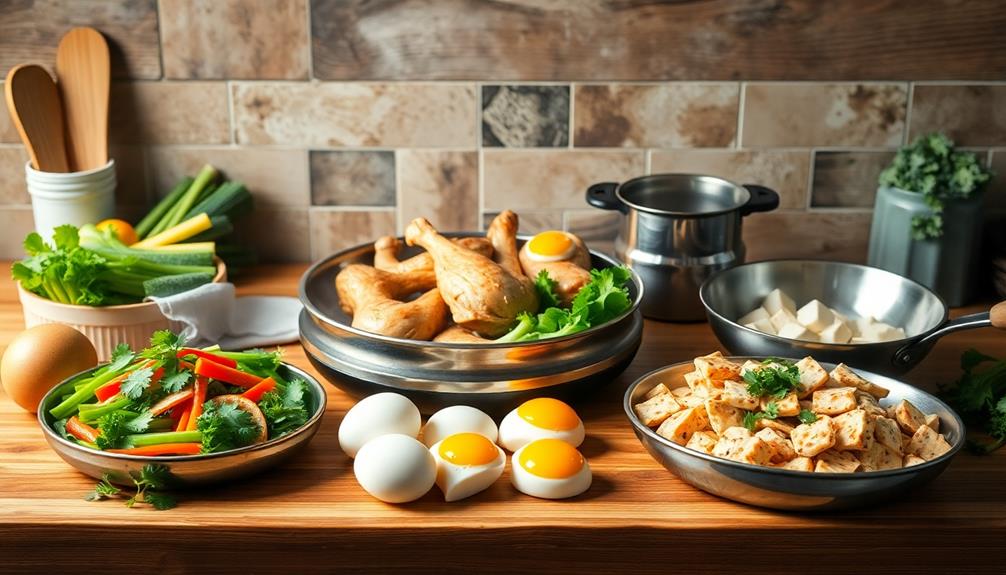
While many people may not realize it, cooking offers significant nutritional benefits beyond just making food palatable. For example, traditional Asian Cuisine often incorporates cooking methods that enhance the nutritional profile of ingredients.
When you cook legumes, you enhance their protein digestibility considerably. This happens because cooking breaks down anti-nutritional compounds that can hinder nutrient absorption. For instance, methods like boiling and pressure cooking can improve protein digestibility by up to 25%.
Microwave cooking is another excellent option, as it often preserves more of the protein content while boosting the bioavailability of essential amino acids. Cooking at ideal temperatures, around 75°C, maximizes protein digestibility and minimizes nutrient loss, with studies showing true ileal digestibility rates averaging an impressive 95%.
These nutritional benefits highlight the importance of cooking not just for flavor but for health as well. By increasing the digestibility of proteins in legumes, you're ensuring that your body can absorb the essential amino acids it needs for various bodily functions.
Comparison of Legume Types

When you're cooking legumes, it's essential to know that different types offer varying nutritional values and protein digestibility.
For instance, traditional dishes like Muamba De Galinha highlight the importance of ingredient selection and preparation in maximizing nutrient absorption.
The cooking method you choose can greatly impact how well your body absorbs these proteins.
Nutritional Value Variations
Legume diversity presents a fascinating array of nutritional value variations, particularly in protein digestibility. When you consider different legume types, you'll notice that their unique amino acid compositions and anti-nutritional factors greatly influence how well your body can digest their protein.
For example, many traditional Mexican dishes, such as chilaquiles, incorporate beans as a key ingredient, showcasing the importance of legumes in enhancing both flavor and nutritional value.
Here's a quick comparison:
- Soybeans: Boasting 36-40% protein, they're among the highest in protein content, but their digestibility can be affected by cooking methods.
- Lentils: With around 25-30% protein, cooking lentils can increase protein digestibility by up to 30%, making them a nutritious option.
- Peas: Similar to lentils in protein content, they also benefit from effective cooking methods that enhance digestibility.
- Processing Techniques: Soaking and fermenting legumes can improve nutritional bioavailability, further increasing the digestibility of proteins and other nutrients.
Understanding these nutritional value variations helps you make informed choices. By selecting the right legume types and cooking methods, you can maximize protein digestibility and decrease anti-nutritional factors.
Cooking Method Impact
Cooking methods can dramatically affect how well your body digests protein from legumes. For instance, pressure cooking greatly enhances protein digestibility compared to ordinary boiling or microwaving. This improvement is essential since different legumes respond uniquely to these methods. While soybean pastes stand out with their unique textural and viscoelastic properties, lentil and pea pastes also benefit from proper cooking.
When you cook legumes, gastrointestinal digestion (GID) boosts protein digestibility across all types. However, the extent of this improvement varies based on both the legume type and the cooking method you choose. Not only does cooking enhance protein digestibility, but it also increases antioxidant activity, which is linked to the release of bioactive peptides during digestion.
Additionally, cooking mitigates the presence of anti-nutritional compounds in legumes, leading to better nutrient absorption. This process ultimately enhances the overall nutritional quality of the prepared pastes, making them healthier options for your meals.
Future Research Directions

Advancements in understanding protein digestibility hinge on future research exploring various cooking methods. Focus on refining these methods can greatly enhance the nutritional quality of both legumes and animal proteins.
Here are some key directions for further investigation:
- Varying Temperature and Duration: Research should examine how different cooking times and temperatures affect protein digestibility while minimizing nutrient loss.
- Pre-Cooking Treatments: Investigating methods like soaking and fermenting could provide valuable insights into improving the nutritional quality of protein sources before cooking.
- Bioavailability of Essential Amino Acids: Exploring specific cooking techniques will help assess their impact on the availability of essential amino acids and peptides during gastrointestinal digestion.
- Anti-Nutritional Factors: Analyzing the interactions between cooking methods and anti-nutritional factors in legumes can lead to strategies that mitigate their negative effects on protein digestibility.
In addition, incorporating consumer preferences and sensory evaluations into future studies can enhance the acceptance and utilization of ideally cooked protein sources in diets.
Frequently Asked Questions
How Does Cooking Impact the Digestibility of Proteins?
Cooking impacts protein digestibility by altering the structure of proteins, making them easier for your body to break down. Different methods can enhance or reduce nutrient availability, so choosing wisely can optimize your protein intake.
Does Cooking Method Affect Protein?
Does cooking method affect protein? Absolutely! You'll find that different techniques can change how well your body absorbs protein. Choosing the right method can enhance your meals' nutritional value, ensuring you get the most benefits.
Which Cooking Method Increases the Digestibility of Protein?
To increase protein digestibility, you should consider methods like pressure cooking or boiling. These methods denature proteins and reduce anti-nutritional factors, enhancing nutrient absorption and ensuring your meals are both nutritious and easy to digest.
How Does Cooking Improve Digestibility?
When you boil beans, you're not just making them tender; you're also breaking down tough proteins. Cooking improves digestibility by denaturing proteins, allowing enzymes to access and absorb essential nutrients more effectively during digestion.
Conclusion
To sum up, understanding how cooking methods affect protein digestibility empowers you to make healthier choices. By boiling, steaming, or adjusting time and temperature, you can enhance the nutritional value of your meals. The differences among legume types remind you that variety is key. As you explore these cooking techniques, you'll not only improve your protein intake but also enjoy the benefits of better digestion and overall health. So, cook wisely, eat well, and thrive!
-

 News3 months ago
News3 months agoYoung Tennis Prodigy Emerges: Merri Kelly Hannity
-

 Lifestyle4 months ago
Lifestyle4 months agoSocial Growth: How to Grow Your Home Decor Instagram Following!
-

 Vetted4 months ago
Vetted4 months ago15 Best Home Decor Dupes That Look Expensive But Are Budget-Friendly
-

 Vetted4 months ago
Vetted4 months ago15 Best Coastal Home Decor Items to Transform Your Space Into a Seaside Oasis
-

 Lifestyle4 months ago
Lifestyle4 months agoShow Your Love: How to Appreciate Someone's Home Decor in 5 Easy Steps!
-
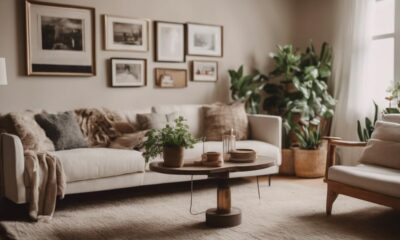
 Lifestyle4 months ago
Lifestyle4 months agoUltimate Guide: How to Arrange Home Decor for a Stunning Look!
-

 Lifestyle4 months ago
Lifestyle4 months agoDIY Window Treatments: How to Install Home Decor Collection Blinds!
-

 Vetted3 months ago
Vetted3 months ago15 Best Fireclay Farmhouse Sinks of 2024 – Style Meets Durability










